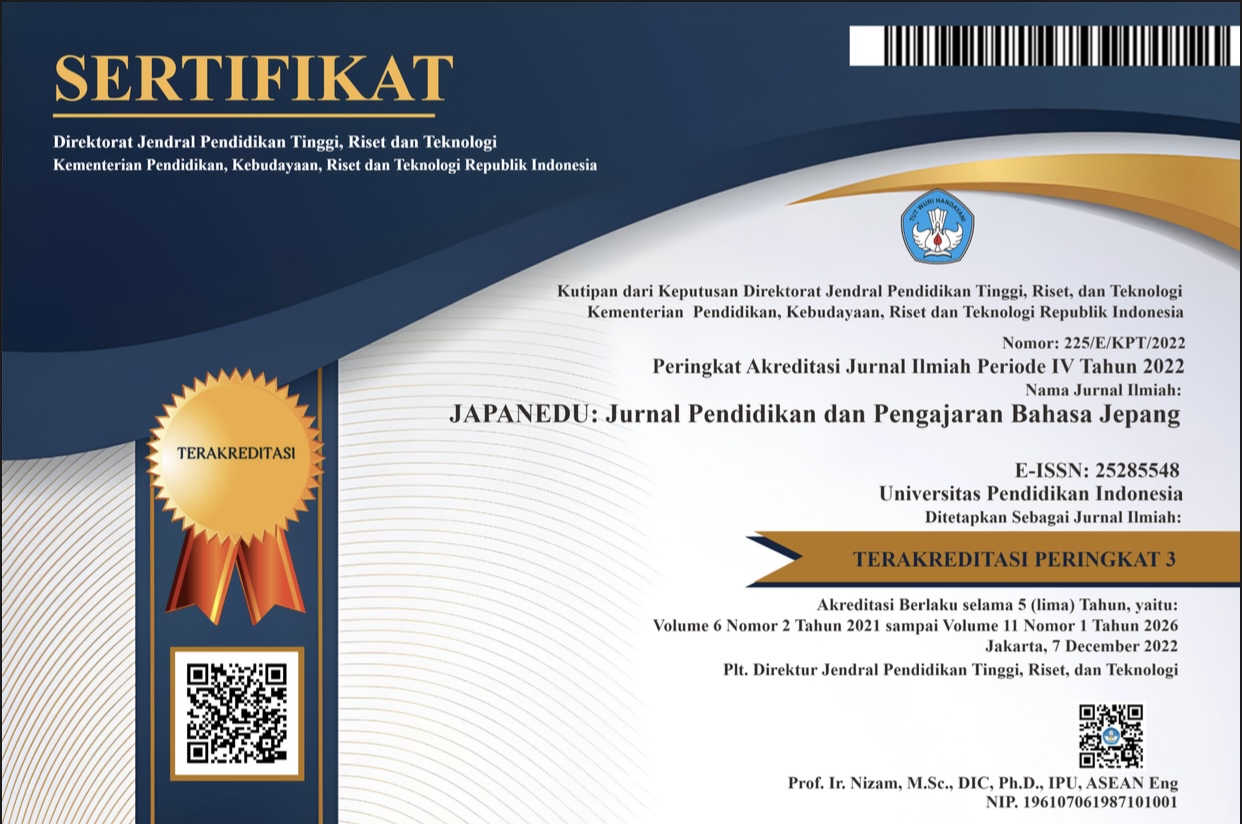日本語ヴォイス構文の指標的機能と話者の選択
Abstract
In previous researches Japanese voice constructions were examined as devices for managing discourse coherence by indicating a person as the focus of attention or of spearker’s empathy. However, in that discourse function a speaker cannot choose the function because it is automatically determined by grammatical and cognitive ways. Previous studies rarely studied the context constitutive choice made by a speaker in every actual language use. This paper aims to explain the functions of Japanese voice constructions which can potentially be a set of options for a speaker’s choice in a discourse, and then examines the speaker’s motivation for the choice made. Introspective and intuitive research method is used to explain the set of options and motivations of speaker’s choice, and each set is assumed to be formed paradigmatically based on functional linguistic theory. The functions of constructions are explained as indexical functions which is developed in the theory of anthropological linguistics. Indexical functions examined here are conventional grammatical knowledges shared in a particular language community. The data used are personal narrative ones. Therefore, the speaker’s focus of attention or empathy no longer need to be questioned here, because in the personal narratives the speaker itself is cognitively the focus of attention. The analysis shows that the indexical functions of constructions chosen by the speaker is roughly divided into two types of indexicals, the first is referential indexicals which express the locus of speaker, directionality, causality, and affectedness of actions, evaluative attitudes towards events, social statuses and powers, and mental attitudes. The second is nonreferential indexicals that express socio-cultural attitudes.
Keywords
Full Text:
PDFReferences
Croft, W., & Cruse, A. (2004). Cognitive Linguisitics. Cambridge University Press.
フォード丹羽順子・小林典子・木戸光子・松本 哲洋(2000)「『構文動機』を記述した日本語教育のための文法:母語話者はなぜその文法形式を使うのか」平成11年度文部省科学研究費補助金基盤研究C(1)(課題番号11680308)
Halliday, M.A.K. (1994). An Introduction to Functional Grammar. Second Edition. London, Melbourne, Auckland. Edward Arnold.
Halliday, M.A.K. & Matthiessen, C.M.I.M. (2014). Halliday’s Introduction to Functional Grammar. 4th edition. USA and Canada. Routledge
早津恵美子 (2005)「現代日本語の『ヴォイス』をどのように捉えるか」『日本語文法』5巻2号 pp.21-38.
片岡邦好 (2002) 「指示的,非指示的意味と文化的実践:言語使用における『指標性』について」『社会言語科学』第4巻第2号, 21-41.
古賀裕章 (2008)「『てくる』のヴォイスに関連する機能」『ことばのダイナミズム』くろしお出版
Mahsun, M.S. (2005). Metode Penelitian Bahasa: Tahapan Strategi, Metode dan Tekniknya. Jakarta. PT. Fraja Grafindo Persada.
益岡隆志 (1991)「受動表現と主観性」『日本語のヴォイスと他動性』くろしお出版
益岡隆志 (2001)「日本語における授受動詞と恩恵性」『言語』大修館書店, 30(5), 26-32.
松本曜 (2011)「作例と内省による研究例1:『類別詞』と『主体的移動』の認知言語学的研究」『認知言語学研究の方法:内省・コーパス・実験』ひつじ書房 , 131-147.
Moleong, L. J. (2007). Metodologi Penelitian Kualitatif. Edisi Revisi. Bandung. PT Remaja Rosdakarya.
村木新次郎(1995[1991a])「ヴォイスのカテゴリーと文構造のレベル」『日本語のヴォイスと他動性』くろしお出版
―――(1996[1991b])『日本語動詞の諸相』ひつじ書房
―――(1999 [1989])「ヴォイス」『日本語の文法・文体:日本語と日本語教育』4巻 明治書院, 169-200.
仁田義雄 (1981)「態」『日本文法辞典』有精堂
――― (1995[1991])「ヴォイス的表現と自己制御性」『日本語のヴォイスと他動性』くろしお出版
野田尚史(1991)「文法的なヴォイスと語彙的ヴォイスの関係」『日本語のヴォイスと他動性』くろしお出版, 211-232.
――― (1995)「『文法的なヴォイスと語彙的なヴォイスの関係』より」『動詞の自他』ひつじ書房, 198-206.
野村剛史(1995)「自動・他動・受身動詞について」『動詞の自他』ひつじ書房, 137-150.
Otsuka, H., Suganda, D., Purwo, B. K., & Sobarna, C. (2018). Fungsi Indeksikal Referensial dan Nonreferensial pada Konstruksi Diatesis Bahasa Jepang (Referential and Nonreferential Indexical Functions in Japanese Voice Constructions). Metalingua: Jurnal Penelitian Bahasa, 16(1), 47-62.
Otsuka, Hiroko. (2018b). Penentuan Pilihan Konstruksi Diatesis oleh Penutur pada Teks Naratif Pribadi Bahasa Jepang: Pendekatan Indeksikal Konteks Konstitutif. (Unpublished Dissertation). Padjadjaran University.
大島デイヴィッド義和 (2011)「内省に基づく意味の研究」『言語研究の技法:データの収集と分析』ひつじ書房, 73-89.
坂原茂 (2003)「ヴォイス現象の概観」『言語』32巻4号 大修館書店, 26-33.
佐藤琢三 (2007 [2005])『自動詞文と他動詞文の意味論』笠間書店
澤田淳 (2006)「ヴォイスの観点から見た日本語の授受構文」『言外と言内の交流分野』大学書林
――― (2000)「ヴォイス」『日本語の文法I:文の骨格』岩波書店
清水啓子(2010)「日本語「動詞+てくる」構文の逆行態用法について」『熊本県立大学文学部紀要』 第16巻, 47-75.
Silverstein, M. (1976). Shifters, Linguistic Categories, and Cultural Description. Basso, Keith., Henry, A. Selby. (Eds.) Meaning in Anthoropology.Albuquer- que: University of New Mexico Press.
住田(2010)「日本語のコミュニケーションにおけるヴォイスの機能」『日語日文学研究』, 74(1), 165-186.
住田(2011)『移動動詞「来る」の文法化とヴォイス機能』神戸大学博士論文
高橋太郎他 (2006[2005])『日本語の文法』ひつじ書房
田中真理 (1996)「視点・ヴォイスの習得:文生成テクとにおける横断的及び縦断的研究」『日本語教育』88号 日本語教育学会, 104-115,
――― (2004)「日本語の『視点』の習得:英語、韓国語、中国語、インドネシア語・マレー語を対象に」『言語学と日本語教育III』くろしお出版
寺村秀夫 (1982[1986]) 『日本語のシンタクスと意味』第1巻 くろしお出版
Verschueren, J. (1999). Understanding Pragmatics. London. Edward Arnold Limited. NY Oxford University Press.
山田敏弘 (1999)『日本語におけるベネファクティブの記述的研究』大阪大学博士論文
――― (2000-2002)「日本語におけるベネファクティブの記述的研究」『日本語学』, 1(14), 明治書院
山本裕子(2002a)「『~テクレル』の機能について:対人調節的な機能に注目して」『言語文化論集』名古屋大学国際言語文化研究科, 127-144.
――― (2002b)「『~テモラウ』の機能について『~テクレル』と対比して」『名古屋女子大学紀要』人文社会編, 48, 263-276.
――― (2003)「『~テアゲル』の対人的な機能についての一考察」『世界の日本語教育』, 13, 143-160.
メディア及びコーパス
「南十字」『じゃかるた新聞』
『現代日本語書き言葉均衡コーパス』(KOTONOHA)
DOI: https://doi.org/10.17509/japanedu.v4i2.18564
Refbacks
- There are currently no refbacks.
Copyright (c) 2019 JAPANEDU: Jurnal Pendidikan dan Pengajaran Bahasa Jepang

This work is licensed under a Creative Commons Attribution-ShareAlike 4.0 International License.
 Published by:
Published by: Department of Japanese Language Education, Faculty of Language and Literature Education
Universitas Pendidikan Indonesia
 Online ISSN: Online ISSN:2528-5548 |

JAPANEDU: Jurnal Pendidikan dan Pengajaran Bahasa Jepang (e-ISSN:2528-5548) lisenced under a Creative Commons Attribution-ShareAlike 4.0 Internasional (CC BY-SA 4.0)


